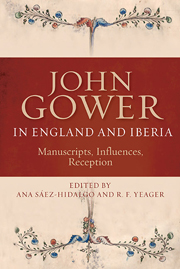Book contents
- Frontmatter
- Contents
- List of Illustrations
- Abbreviations
- Introduction
- I Manuscripts
- 1 Castilian Script in the Iberian Manuscripts of the Confessio Amantis
- 2 Provenance Interlacing in Spanish Royal Book-Collecting and the Case of the Confessio Amantis (RB MS II-3088)
- 3 Inglorious Glosses?
- 4 The Yale Gower Manuscript, Beinecke Osborn MS fa.1: Paleographical, Codicological, Technological Challenges and Opportunities
- II Iberia
- III The Classical Tradition
- IV Economy
- V Reception
- Notes on Contributors
- Bibliography
- Index
1 - Castilian Script in the Iberian Manuscripts of the Confessio Amantis
from I - Manuscripts
Published online by Cambridge University Press: 05 August 2014
- Frontmatter
- Contents
- List of Illustrations
- Abbreviations
- Introduction
- I Manuscripts
- 1 Castilian Script in the Iberian Manuscripts of the Confessio Amantis
- 2 Provenance Interlacing in Spanish Royal Book-Collecting and the Case of the Confessio Amantis (RB MS II-3088)
- 3 Inglorious Glosses?
- 4 The Yale Gower Manuscript, Beinecke Osborn MS fa.1: Paleographical, Codicological, Technological Challenges and Opportunities
- II Iberia
- III The Classical Tradition
- IV Economy
- V Reception
- Notes on Contributors
- Bibliography
- Index
Summary
As can be seen from its title, our work centers on the study of the Iberian manuscripts of the most celebrated work by the poet John Gower, the Confessio Amantis, which in the fifteenth century was translated from the original Middle English first into Portuguese and afterwards into Castilian, using the Portuguese translation as a base. The bastard Gothic script of the Portuguese manuscript and the Gothic court hand of the Castilian translation were both familiar in the Portuguese and Castilian courts in the fifteenth century. As a result, books written in bastard were read by Portuguese kings, princes, and courtiers at the time the extant copy of the Livro do Amante (as the Portuguese translation is titled) was produced. Similarly, books written in court hand were commonly read by kings, princes, and members of the Castilian court at the time when that the single surviving copy of the Castilian translation, the Confisyón del Amante, was made. Neither script, therefore, renders either of these manuscripts different from other books or documentary products of this time and place – especially the latter, in the case of Castile.
Codicological study – careful examination of books themselves – permits us further to confirm what is implicit in the scripts: in this case, the hands in which the Iberian translations of the work of John Gower were copied. Based on both paleographic and codicological studies, we are able to make four major observations about these two manuscripts.
- Type
- Chapter
- Information
- John Gower in England and IberiaManuscripts, Influences, Reception, pp. 17 - 32Publisher: Boydell & BrewerPrint publication year: 2014



